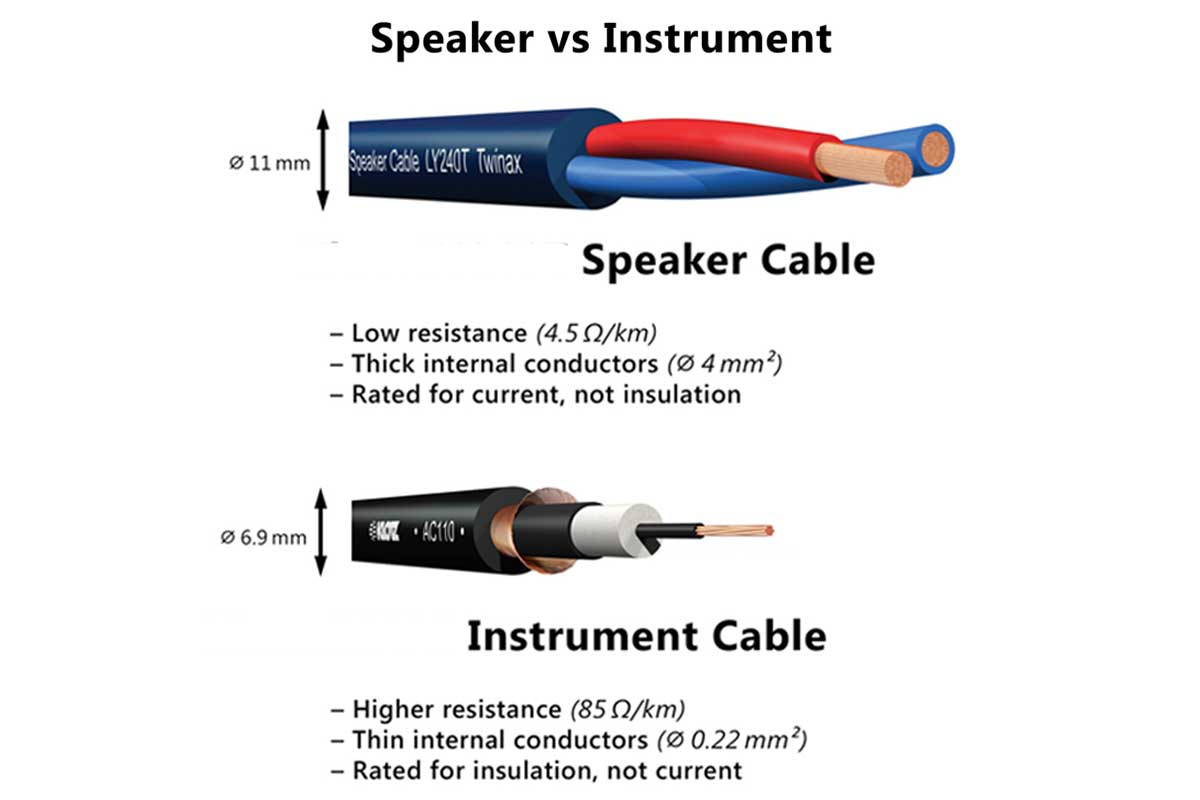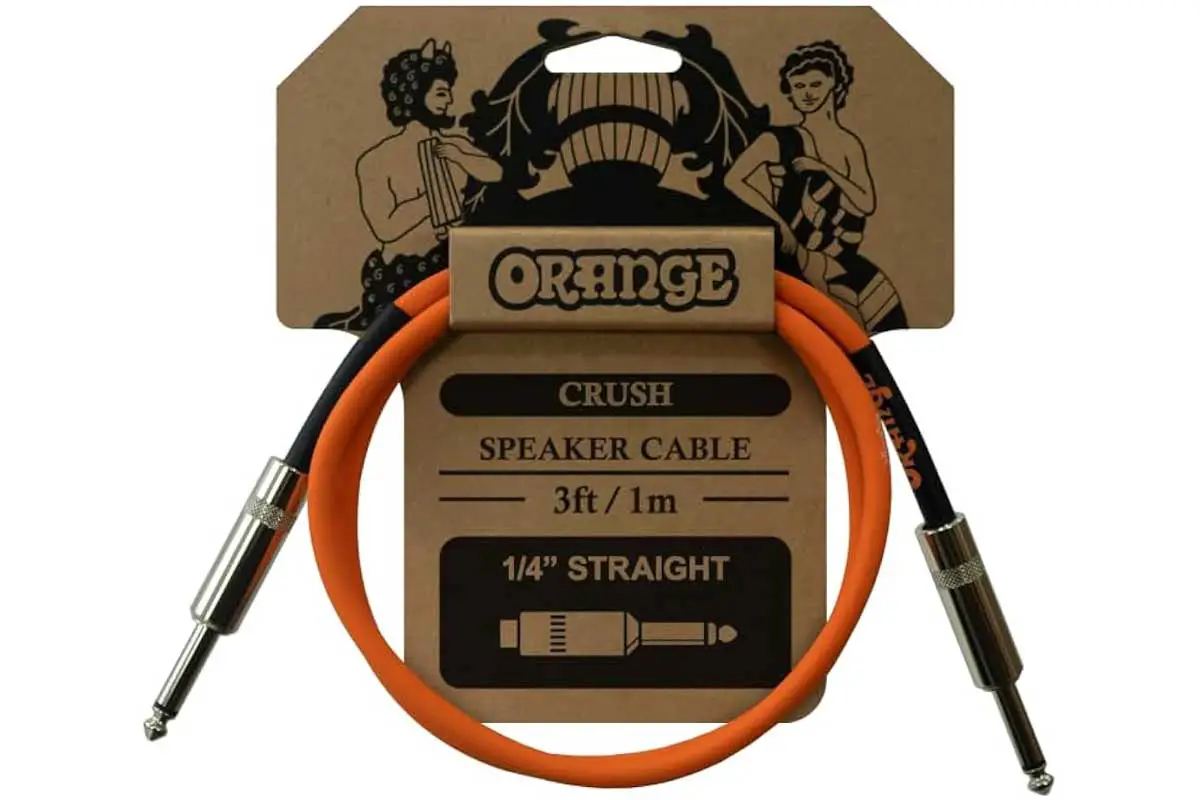When setting up your music gear, it’s crucial to understand the differences between speaker cable vs instrument cable, as using the wrong type can lead to poor performance or damage to your equipment. Speaker cables are designed to connect amplifiers to speakers, carrying high-power amplified signals. These cables are typically thicker because they need to handle the higher current demands of speaker-level signals without heating up or degrading the tone of your sound.
In contrast, instrument cables are used to connect instruments like guitars or keyboards to an amplifier or audio interface. They are crafted to carry much lower voltage signals and are equipped with shielding to protect the integrity of the signal from electronic noise and interference. While they may look similar, using an instrument cable to connect an amp to a speaker can result in a loss of tone and potentially harm your amplifier due to its inability to handle the required power.
Understanding these differences ensures that you, as a musician or audio technician, make the right choice for each application. Using the correct cables preserves the tone of your instrument and ensures that your equipment delivers its best performance without risk of damage, keeping your setup reliable for every practice session or live show.

Physical Differences
When considering speaker cables and instrument cables, it’s essential to understand their physical differences, as these differences directly impact their performance and suitability for specific audio applications.
Construction and Materials
Speaker cables and instrument cables differ in construction, primarily due to the materials used. Speaker cables typically feature copper wiring for the core conductor due to its excellent electrical conductivity. The gauge, or thickness, of the wire is also a crucial factor; speaker cables often employ a thicker gauge to handle higher current flow. This enhances the overall power handling and reduces resistance. For insulation, rubber or polyester compounds are common, providing durability and resistance to interference.
Instrument cables, while also using copper wiring, are built with a focus on preventing signal loss and protecting the integrity of the instrument’s sound. They include a capacitive element to manage impedance and often utilize a braided wire mesh or foil wrap, which acts as a shield to minimize electromagnetic interference.
Cable Connectors
Cable connectors are integral to cable function, facilitating the connection between devices. Instrument cables usually have 1/4-inch jacks or plugs with a tip-sleeve design. The connectors may be made of nickel or gold—gold being preferred for its resistance to corrosion and superior conductivity.
Speaker cables, however, do not require connectors with capacitive characteristics. The connectors are typically heavier-duty to accommodate the thicker gauge wire and higher current, and they might also employ 1/4-inch jacks or professional Speakon connectors.
Cable Design Variations
The design of these cables often varies to optimize performance for their intended use. Instrument cables are designed with the musician’s mobility in mind and are more flexible. They often include features like additional shielding to minimize the noise from movement and handling.
Speaker cables, by contrast, focus on power transmission and may forgo the braided mesh in favor of other shielding methods that handle higher power loads without capacitance issues. The construction can vary from simple parallel wires to complex multilayer designs with dedicated shielded paths for different frequencies.
Functional Variables of Speaker Cable vs Instrument Cable
When considering speaker cables and instrument cable, the main differences squarely impact their performance. This pertains particularly to how they manage signal flow, their resilience to interference, and power handling capacity.
Signal Flow and Interference
Your instrument cable is tailored for high impedance signals produced by electric guitars and basses. It’s designed to carry a low-level signal which is more susceptible to loss if transmitted over long distances. Therefore, these cables usually have a capacitive nature which can affect the tone of your instrument. Instrument cables often include shielding to protect the integrity of these signals against interference, like radio-frequency (RF) and electromagnetic interference (EMI), maintaining a clear signal-to-noise ratio.
| Feature | Instrument Cable | Speaker Cable |
|---|---|---|
| Signal Type | High impedance, low-level | Low impedance, high power |
| Shielding | Heavier to minimize interference | Lighter, as not susceptible to interference |
| Twisted Design | Rare, as it prioritizes shielding | Often twisted to reduce interference |
Power Handling Capacity
Speaker cables, in contrast, are built to carry a powerful current from your guitar amplifier to the loudspeakers. Dealing with much low impedance, these cables can transmit a high power signal without significant loss, which is not the case with instrument cables. Speaker cables lack extensive shielding since they carry a stronger current that is less vulnerable to external noise. Because of their build, there’s less chance of heat build-up and overheating, even when dealing with high voltage levels needed to drive your speakers.
| Property | Instrument Cable | Speaker Cable |
|---|---|---|
| Current | Low | High |
| Voltage | Relatively low | Higher, as dictated by amplifier output |
| Risk of Overheating | Higher due to thin conductors | Lower due to thick conductors and large wire gauge |
| Typical Use | Signal connection between instrument and amp | Power connection between amp and speaker |
Remember that using the wrong type of cable for your setup can result in loss of tone quality, increased noise, or even damage to your equipment.
Practical Implications and Usage
In considering speaker cables vs instrument cables, it’s crucial to understand their differing impacts on sound quality and where each should be optimally used.
Impact on Sound Quality
Your choice between speaker and instrument cables can greatly affect sound fidelity. Speaker cables are designed to carry a high-power audio signal from an amplifier to a speaker. They have a thicker conductor, which minimizes power loss and prevents distortion. In contrast, instrument cables are designed with a focus on shielding to protect the integrity of the low-level signal from instruments. They are typically constructed with a single conductor wrapped by a shield to reduce hum, buzz, and unwanted noise. Mixing these cables can compromise your rig‘s audio quality, causing loss of clarity or introducing noise.
Related: Troubleshooting a Buzzing Amp
Usage Scenarios
In the studio, instrument cables are the lifeline for a clean signal path from guitars and other instruments to the mixing console. Good quality instrument cables can shield against electromagnetic interference, ensuring high fidelity in your recordings. However, for live performances or a gig, robust speaker cables are indispensable. These cables ensure that the amplified sound reaches the speakers with full power, maintaining sound quality over longer distances without noise and distortion.
When setting up your studio or live rig, always use the appropriate cable for the task to ensure the clearest sound and most reliable performance.
Choosing the Right Cable
Selecting the appropriate cable for your equipment is paramount to maintain performance and prevent damage. Whether you’re connecting instruments to amps or ensuring your speakers are properly wired, understanding the nuances between speaker cable vs instrument cable is crucial.

Recommendations for Instruments
When it comes to instrument cables, typically used for guitars or basses, search for cords with robust connectors and adequate shielding to minimize noise and interference. Your instrument pickups are susceptible to picking up hum and buzz, so a low-capacitance cable helps preserve your signal’s integrity. Always opt for a cable with the right length; a short cable ensures less signal loss, but make sure it’s long enough for your mobility.
- Connectors: Look for 1/4-inch connectors that are sturdy and have a firm grip.
- Impedance: Your instrument cable should match the impedance of your pickups to avoid tone loss.
- Shielding: A braided shield or serve shield resists interference from other electronic devices.
- Durability: Manufacturers often use tough materials like tweed or reinforced plastic for the outer layer to prevent wear.
Considerations for Amplification Systems
When connecting an amp to a speaker cabinet, you’ll require a speaker cable, which is different from an instrument cable. Speaker cables are designed to handle the high current output from amplifiers, ensuring your sound reaches the speaker cabinet with minimal loss. They often have a thicker gauge, which directly affects the performance since it influences the cable’s ability to carry more current.
To maintain your system’s integrity, it’s essential never to use an instrument cable as a speaker cable. Doing so can result in negative consequences, like damaging your amp because instrument cables are not built to handle the power that an amplifier sends to a speaker cabinet.
- Gauge: A thicker wire gauge (lower AWG number) for speaker cables is ideal for longer runs to reduce resistance.
- Cable length: Keep speaker cables as short as practical to improve sound quality and reduce potential damage.
- Connectors: Ensure connectors like banana plugs, speakON, or 1/4-inch are secure and provide a positive connection.
- Manufacturer: Trusted manufacturers ensure reliability and safety in their speaker cable designs.
